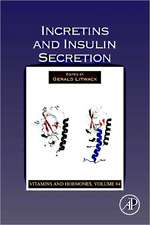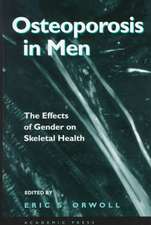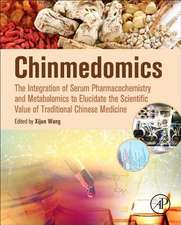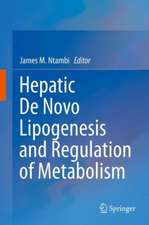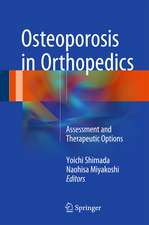Oxidative Stress Mechanisms and their Modulation
Autor Mohinder Bansal, Naveen Kaushalen Limba Engleză Paperback – 22 sep 2016
| Toate formatele și edițiile | Preț | Express |
|---|---|---|
| Paperback (1) | 637.46 lei 6-8 săpt. | |
| Springer India – 22 sep 2016 | 637.46 lei 6-8 săpt. | |
| Hardback (1) | 644.95 lei 6-8 săpt. | |
| Springer India – 3 noi 2014 | 644.95 lei 6-8 săpt. |
Preț: 637.46 lei
Preț vechi: 749.95 lei
-15% Nou
Puncte Express: 956
Preț estimativ în valută:
121.99€ • 124.93$ • 101.48£
121.99€ • 124.93$ • 101.48£
Carte tipărită la comandă
Livrare economică 19 martie-02 aprilie
Preluare comenzi: 021 569.72.76
Specificații
ISBN-13: 9788132228790
ISBN-10: 8132228790
Pagini: 185
Ilustrații: XVIII, 167 p. 25 illus., 4 illus. in color.
Dimensiuni: 178 x 254 x 10 mm
Greutate: 0.34 kg
Ediția:Softcover reprint of the original 1st ed. 2014
Editura: Springer India
Colecția Springer
Locul publicării:New Delhi, India
ISBN-10: 8132228790
Pagini: 185
Ilustrații: XVIII, 167 p. 25 illus., 4 illus. in color.
Dimensiuni: 178 x 254 x 10 mm
Greutate: 0.34 kg
Ediția:Softcover reprint of the original 1st ed. 2014
Editura: Springer India
Colecția Springer
Locul publicării:New Delhi, India
Cuprins
1. Introduction to Oxidative Stress.- 2. Oxidative Stress in Pathogenesis.- 3. Oxidative Stress in Metabolic Disorders/Diseases.- 4. Oxidative Stress and Carcinogenesis.- 5. Cell Signaling and Gene Regulation by Oxidative Stress.- 6. Managing Oxidative Stress/Targeting ROS.- 7. Selenium, a Potent Natural Antioxidant.- 8. Future Perspective.
Notă biografică
Dr M.P. Bansal did MSc (H) in Biophysics in 1972 and PhD in 1980 on carcinogenesis from Panjab University, Chandigarh (India). He worked as faculty member since 1978 in the Department of Biophysics, Panjab University (Chandigarh, India) and superannuated in 2008 as Professor. He has also worked as a research associate and visiting faculty at Baylor College of Medicine, Houston, Texas, USA. During this period, he has worked on the isolation and characterization of selenoproteins and also published work in reputed scientific journals. His core area of the study involved molecular pathophysiology under the influence of experimental oxidative stress and its modulation in spermatogenesis and atherosclerosis. Regulation of gene expression related to the endogenous antioxidative enzymes, transcription factors and their upstream activators (MAP kinases) were studied at transcriptional and translational level. Dr Naveen Kaushal received his Bachelor’s and Master’s degrees in Biophysics(H) in 2004 and earned his PhD in Biophysics essentially in the field of Molecular biology from Panjab University, Chandigarh (India) in 2008. Kaushal’s doctoral research demonstrated the role of selenium, an essential dietary micronutrient and antioxidant, acts in a well-coordinated manner to maintain the cellular redox status and male germ cell maturation during spermatogenesis. Dr Kaushal joined the faculty of physiology at Gian Sagar Medical College and Hospital, Punjab (India) in 2007 as Assistant Professor. Thereafter, he joined The Pennsylvania State University, USA as a postdoctoral fellow. Dr Kaushal’s research has focused on scientific areas pertaining to delineate the redox regulated molecular pathways of pathogenesis and their plausible modulation by nutritional interventions, by selenium and EPA. His research in this direction led to the discovery of a novel prostaglandin that holds potential to cure leukemia and prevent its relapse. With the success of these projects, he has beenrecently recognized as “Future leader in Nutrigenomics-2013" by Nebraska Gateway to Nutrigenomics (NGN), USA. With his keen interest in the redox biology, he aims to translate the role of active dietary antioxidants in developing superior or adjunct therapies for various diseases.
Textul de pe ultima copertă
Research over the years has demonstrated that free radicals mediated oxidative stress lies at the helm of almost all patho-physiological phenomena. These findings emphasize on the need to understand the underlying molecular mechanism(s) and their critical role in the pathogenesis. This book aims to focus on these areas to provide readers a comprehensive outlook about the major redox sensitive pathways and networks involved in various disease conditions. In the first chapter of the book, basic information about the oxidative stress, its generation, its biomarkers and its role in body are discussed. In the next three chapters, the role of oxidative stress in various pathologies ranging from neurological disorders, to cardiovascular diseases, cancers, metabolic diseases and ageing have been described. Chapter 5 cumulatively describes the most important molecular signaling pathways that are affected by reactive oxygen species (ROS). These are the mechanisms which are common denominatorsin various pathological states. In the next part of the book, various antioxidant strategies to target and mitigate ROS have been discussed with details on the mechanisms. Selenium, being the research focus and interest of the authors for years, the role of selenium as an antioxidant as part of selenoproteins has been included in the book. Finally, the book culminates with authors’ perspective on the future of the redox biology field. Throughout the book, efforts have been made to use simplified language and suitable figures for ease to understand the contents. Although the authors have tried to touch on all the different aspects of oxidative stress in detail, the fact that it is a continuously growing field with updates coming every day, there might be some areas which might not be described in depth. This book is designed for students, young scientists to get acquainted with the redox biology. Overall, this book is a reference to understand the redox regulation of cellular signalingpathways involved in pathogenesis.
Caracteristici
Gives an overview of mechanisms underlying oxidative stress in lifestyle diseases like diabetes and obesity Oxidative stress in relation to cancer gives an insight into the disease and its possible management Discusses in detail about the state-of-the-art technologies like clinical markers to manage oxidative stress Reports cutting-edge research that explores events mediating or preventing oxidative stress Includes supplementary material: sn.pub/extras


